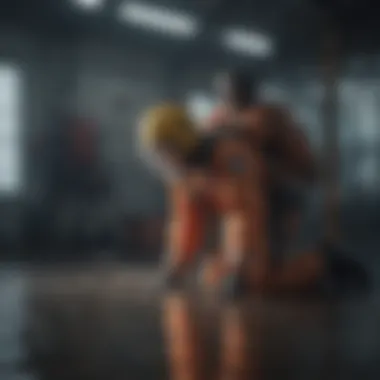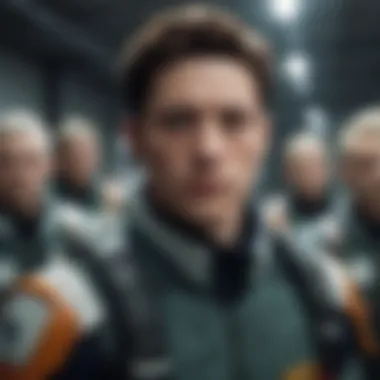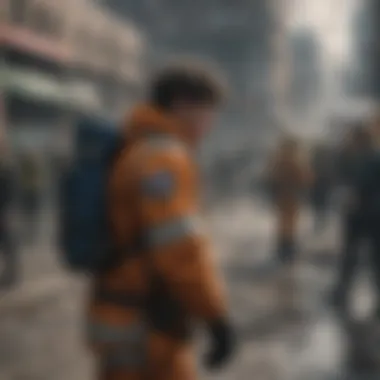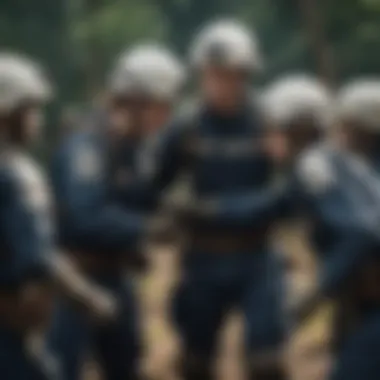The Art of Save and Rescue Training in My Hero Academia


Intro
In the universe of My Hero Academia, save and rescue training represents a cornerstone of hero education. Beyond the flashy quirk battles and intense showdowns, this specialized training brings characters face to face with the weight of responsibility that accompanies their powers. This exploration of save and rescue training goes beyond technique; it embeds within it the essence of heroism, ethics, and character growth.
Understanding the intricacies of how hero training works within this fictional framework provides deeper insights into the development of its protagonists and the larger themes woven into the story. Through examining key training sessions, their outcomes, and the philosophical underpinnings, we uncover a narrative that reflects on society’s expectations of heroes.
As we progress through this article, we will analyze how these training arcs contribute to character arcs and the collective understanding of what it means to be a hero in a world filled with superpowers and moral dilemmas.
Defining Save and Rescue Training
Save and rescue training is a core component of hero education in the universe of My Hero Academia. This training embodies the principles, skills, and ethics required to effectively respond to emergencies. It goes beyond physical ability or combat prowess; it centers on saving lives and protecting citizens. This section aims to illuminate the importance of save and rescue training in shaping both individual heroes and societal perspectives on heroism.
Understanding the Concept
At its core, save and rescue training involves preparing individuals to handle critical situations where human lives are at stake. This training encompasses various skills such as crisis management, quick decision-making, and teamwork. It is not solely about using one’s Quirk, but also about employing sound judgment during crises. Heroes in My Hero Academia must learn how to assess situations, act with compassion, and prioritize the well-being of those who need assistance. They need to develop a keen awareness of their surroundings and understand how to utilize their abilities effectively during real-world emergencies.
Moreover, the training fosters essential values, such as courage and empathy. Understanding the concept of heroism goes hand in hand with understanding the responsibility that comes with being a hero. Training in save and rescue not only equips aspiring heroes with the necessary skills but also instills a deeper understanding of their roles in society.
Historical Context in Hero Society
In My Hero Academia, the historical context of heroism is rooted in Japan’s culture and societal expectations. The existence of Quirks has transformed the nature of society, creating a need for structured systems to protect citizens. The rise of professional heroes led to a formalization of training methods, including save and rescue training.
Traditionally, heroes in Japan have been viewed as symbols of hope and strength. However, with the increase in villain attacks and emergencies, the significance of save and rescue training became even more pronounced. It reflects a shift from purely fighting villains to a more rounded approach, where protecting civilians takes precedence.
Training methodologies have evolved over time to adapt to these challenges, resulting in new techniques and philosophies. Today, save and rescue training symbolizes the evolving nature of hero society—a society where being a hero is about much more than just having power. It encapsulates the essence of responsibility that accompanies Quirk usage.
"To be a hero is to protect those who cannot protect themselves. This ethos drives every aspect of save and rescue training."
Hero courses at U.A. High School are designed to prepare students for the intricacies of this evolving professional landscape. The historical context provides a backdrop for understanding why such training has become indispensable in ensuring the safety and security of society as a whole.
My Hero Academia's Approach to Training
The training methodologies utilized in My Hero Academia are pivotal in shaping the next generation of heroes. This approach not only emphasizes the development of superpowers but also underscores the essential skills required for save and rescue operations. The narrative intricately intertwines character development with rigorous training protocols, presenting a multifaceted perspective on heroism. In the intense environment of U.A. High School, students engage in a comprehensive curriculum designed to cultivate both physical and mental resilience.
Overview of U.A. High School's Training Program
U.A. High School is integral to the educational landscape for aspiring heroes. The institution offers a well-structured program that focuses on quirk training, combat strategies, and practical rescue scenarios. Each student’s journey is personalized to leverage their unique abilities while addressing their shortcomings.
The training regimen consists of various components:
- Physical Training: Enhancing strength, agility, and stamina.
- Quirk Applications: Developing effective use of their superpowers.
- Rescue Operations Simulations: Engaging in real-world scenarios to ensure readiness.
This multifaceted approach ensures that students not only protect society but also develop the emotional intelligence to lead during crises. The inclusion of real-life rescue techniques fosters a deeper understanding of hero responsibility.
Key Figures in the Training Process
The training program at U.A. High School is heavily influenced by key figures who play varying roles in shaping the future heroes.
All Might


All Might, known for his unparalleled strength and charisma, serves as the primary mentor for many students. His symbol of peace status significantly impacts student morale and inspiration. All Might emphasizes the importance of being a hero beyond just fighting villains. His approach combines:
- Motivational Teaching: Encouraging students to find their own paths.
- Practical Demonstrations: Showcasing the application of various quirks in real-time situations.
The unique feature of All Might is his ability to inspire fearlessness in students. However, his struggle with injuries adds a layer of realism regarding the physical toll of heroism.
Gran Torino
Gran Torino represents the wisdom of experience. As All Might's former teacher, he brings a tactical perspective to training. His unconventional methods challenge students to think critically and adapt quickly.
- Key Characteristic: A focus on agility and quick thinking in combat and rescue scenarios.
- Innovative Techniques: Training students to use their quirks in unexpected ways.
Gran Torino's training style sharpens the students’ instincts, making them better equipped for unpredictable crises. However, his methods can sometimes be perplexing, leading to frustration among newcomers.
Recovery Girl
Recovery Girl plays a vital role as the school nurse, addressing the physical ramifications of training. Her ability to heal students after strenuous training sessions highlights the importance of recovery in a hero's journey.
- Essential Characteristic: The emphasis on self-care and awareness of one's limits.
- Unique Feature: Providing lessons on resilience and understanding recovery processes.
Though her methods may seem less direct compared to combat training, Recovery Girl's influence is foundational to sustaining physical and mental health among aspiring heroes. This ensures they remain in peak condition for their eventual missions.
"A hero's strength is not just in their quirk but in their ability to endure and adapt." - Gran Torino
In summary, U.A. High School's training program is a blend of specialized training, physical conditioning, and emotional support, forming a robust plan for developing competent heroes. The efforts of key figures like All Might, Gran Torino, and Recovery Girl create a balanced environment that prioritizes both skill and responsibility.
Narrative Importance of Save and Rescue Training
Save and rescue training in My Hero Academia is crucial not just for character development but also for illustrating broader themes of courage and ethical responsibility. This aspect deepens the narrative, providing both tension and empathy. Characters undergo significant growth as they face real-world challenges in training scenarios, enhancing their understanding of heroism. Through intense simulations, trainees learn not only about their quirks but also about the weight of their responsibilities.
The training sessions challenge the characters emotionally and physically. They reveal personal demons, aspirations, and the long-term impacts of their choices. By spotlighting these training exercises, the series articulates that the path of a hero is not solely about power but also about making the right choices when others depend on them.
Character Development Through Training
Midoriya's Growth
Midoriya Izuku's growth is central to understanding save and rescue training in the series. Initially seen as powerless, Midoriya evolves significantly through his training experiences. His transformation into a capable hero reflects the character’s relentless determination and emotional resilience. This growth is compelling because it invites viewers to engage with his struggles. With each training session, he becomes more skilled not just in using his quirk, One For All, but also in understanding the responsibilities that come with being a hero.
One unique feature of Midoriya's growth is his ability to analyze situations critically. This characteristic provides him with a tactical advantage and highlights the importance of strategic thinking in rescue operations. This specific aspect makes him relatable, as many viewers resonate with the notion of overcoming challenges through hard work and perseverance.
Bakugo's Transformation
In contrast, Katsuki Bakugo's transformation during save and rescue training also plays an important role. Bakugo starts as an arrogant character who views strength as the only measure of a hero. His development throughout the training arcs illustrates a more complex understanding of heroism. He learns to work in a team, relying on others' strengths rather than solely depending on his explosive quirk.
The key feature of Bakugo's transformation is his evolving perception of what it means to be a hero. His journey offers a valuable perspective on pride and vulnerability. This development reflects the message that heroism often requires humility and teamwork. It serves as a beneficial portrayal that resonates with audiences, showing that every hero has room to grow and adapt.
Themes of Sacrifice and Responsibility
The themes of sacrifice and responsibility are deeply interwoven into the narrative of save and rescue training. Characters are frequently confronted with dilemmas that force them to prioritize others over themselves. This introduces a moral complexity that challenges their ideals of heroism. In one situation, trainees might have to save a fellow student at the risk of failing their own training, illustrating the sacrifices heroes must be willing to make.


The recurring emphasis on these themes emphasizes that real heroism is not just about gaining attention or personal glory, but about serving others in critical moments. This lesson resonates with the audience, reinforcing the notion that true heroism involves sacrifice and a palpable sense of duty.
Key Episodes Highlighting Training
The exploration of key episodes in My Hero Academia underscores the importance of save and rescue training within the narrative. These episodes serve not only as critical learning experiences for the characters but also as vital plot points that reveal themes of heroism, sacrifice, and personal growth. The significance of these arcs cannot be overstated, as they define the characters' journeys while showcasing the complexities of their chosen path.
The Training Camp Arc
The Training Camp Arc is pivotal in the series, capturing the essence of hero training in a high-pressure environment. It offers a well-crafted blend of physical challenges and emotional depth. The camp is not merely about honing Quirk skills; it emphasizes teamwork, strategy, and resilience in the face of adversity. Each character faces unique obstacles, which fosters personal growth and camaraderie.
In this arc, students from U.A. High School engage with real dangers, simulating the stress and unpredictability of hero work. The influence of the villains, the League of Villains, introduces an existential threat. By confronting these challenges, the characters learn to rely on each other, developing a stronger sense of unity and purpose.
This arc also dives deep into Midoriya’s growth, as he starts understanding the essence of heroism more profoundly. He learns that heroes must also support one another, often putting their own safety at risk for their peers. This instance emphasizes the notion of sacrifice inherent in hero training, making it a compelling narrative device for character development.
The Provisional Hero License Exam
The Provisional Hero License Exam is another cornerstone in understanding save and rescue training. This arc tests not just the physical prowess of the students, but their ability to think on their feet during crises. The exam simulates real-world scenarios where students must employ their Quirks effectively while making quick decisions.
This episode is rich with competitive and collaborative elements. Students must navigate conflicting motivations and ethics, as they face other aspiring heroes. It further underscores the idea of responsibility that comes with power. The stakes are high, and the pressure significantly impacts the characters, pushing them toward self-realization.
Midoriya again steps into the spotlight, showcasing his evolution as he orchestrates strategies that highlight the importance of saving lives over merely winning. He exemplifies what it means to be a true hero amid fierce competition. Additionally, Bakugo's transformation plays a crucial role in this arc, as he learns valuable lessons about teamwork despite his strong-willed and solitary nature.
"True heroes put the lives of others before their own ambition."
Challenges Faced During Training
The journey of heroes in My Hero Academia is not merely defined by their Quirks or powers. It encompasses a variety of challenges that mold their capabilities and character. Understanding these challenges offers insight into what it truly means to undergo save and rescue training. It reveals how characters navigate their paths, enhancing their growth while achieving their goals.
Physical and Psychological Obstacles
During training, heroes-in-training encounter numerous physical hurdles. Climbing high walls, dodging obstacles, and rescuing individuals from simulated disasters demand great physical prowess. The intensity is often amplified by fatigue, pushing these young heroes to their limits. They must develop strength, agility, and endurance. For example, during training camps, characters face extreme conditions designed to test their resilience and response times under pressure.
However, the physical aspect is just one layer of challenges. Psychological barriers play equally significant roles. Characters frequently grapple with self-doubt, fear of failure, and the pressure to perform. Midoriya Izuku, a central figure in the story, battles his insecurities throughout his journey. His success is rooted not just in overcoming physical obstacles but also in mastering his mindset. Training regimens thus also emphasize mental fortitude, with instructors focusing on confidence-building exercises that prepare students for real-world heroics.
Real-World Implications of Hero Training
The challenges of save and rescue training reflect broader societal realities. Training in My Hero Academia mirrors real-world rescue strategies where preparedness is vital. In dynamic environments, such as during natural disasters or crises, heroes must respond swiftly to unpredictable variables. Hero students are taught the importance of teamwork, communication, and crisis management. These training sessions are designed to be as practical as possible, enabling students to simulate real-life scenarios, thus bridging the gap between their training experiences and potential future roles as heroes.
Moreover, the training teaches valuable lessons about responsibility. Each character learns that their Quirks come with significant duties. This realization aligns their training with the concept of heroism beyond mere combat. The cultivation of empathy becomes crucial, ensuring that the heroes can save and rescue individuals not just effectively, but also compassionately.
"Real-world scenarios emphasize the understanding that every decision made in the field has consequences. This training prepares heroes for actual crises, not just textbook examples."
As these students face diverse challenges, they grow and evolve, learning to balance their abilities with ethical considerations. Training in My Hero Academia can serve as an allegory for the responsibilities one has when blessed with unique abilities, encouraging a harmonious blend between power and duty in their climb to becoming true heroes.
Each character's ability to confront physical and psychological obstacles significantly enhances their hero training journey, shaping them into individuals ready to face the complexities of a hero's life.
The Role of Quirks in Save and Rescue
The importance of quirks in the My Hero Academia universe cannot be overstated. Quirks are variations of superpowers that each character possesses, shaping their abilities and defining their role in society. In the context of save and rescue training, these quirks become not just tools for heroism, but essential components enabling heroes to respond effectively to crises. Through nuanced exploration, we can see how quirks enhance training processes, influence teamwork, and impact real-world rescue scenarios.


Diversity of Quirks Among Characters
Every character in My Hero Academia possesses a unique quirk, which can vary greatly in type and application. This diversity presents both advantages and challenges within save and rescue training.
- Some quirks, like Froppy’s ability to mimic frogs, allow for inventive solutions to rescue situations, utilizing agility and stealth.
- On the other hand, Bakugo's explosion-based quirk offers more direct force but requires careful control to avoid collateral damage.
The variety in quirk capabilities necessitates tailored training approaches. Instructors at U.A. High School focus on developing experiences that maximize each hero's potential. For instance, teamwork training helps students learn how to integrate different quirks effectively. This reliance on collaboration not only enriches training but also prepares future heroes for real obstacles they might face.
Innovation in Rescue Techniques
The presence of quirks has led to innovative techniques in the realm of rescue efforts. Students learn to think creatively about how to utilize their abilities in practical scenarios.
- For example, Ochaco Uraraka's anti-gravity quirk enables the safe transportation of individuals from dangerous situations. Her innovative rescuing method has influenced how rescue operations are taught at U.A.
- Moreover, the technological advancements in support items, such as Best Jeanist's support gear, highlights how quirks influence broader rescue strategies.
The continuous evolution of techniques ensures that save and rescue training remains relevant. Heroes are taught not only to harness their quirks but also to adapt their approaches based on situational needs. This adaptability is paramount in preparing for unpredictable real-world crises.
"The fusion of individuality and collaboration among quirks creates a dynamic framework for training, pushing the boundaries of potential in heroism."
In summary, quirks play a critical role in shaping the narrative and practical application of save and rescue training in My Hero Academia. Their diversity enhances training, while innovative techniques foster a readiness among heroes, making them highly effective in crisis situations.
Comparative Analysis with Real-World Rescue Training
The topic of comparative analysis with real-world rescue training is integral to understanding the portrayal and impact of heroism in My Hero Academia. By examining the methodologies used in the anime's save and rescue training with actual rescue operations, we can extract valuable insights. This analysis fosters a deeper appreciation for character development, ethics of heroism, and the realism infused in the fictional narrative. It also illuminates the lessons applicable in real-life scenarios, bridging the gap between fiction and reality.
Emergency Management Strategies
In My Hero Academia, emergency management strategies are central to the training programs. The characters must learn to assess situations quickly, evaluate risks, and apply their quirks effectively in chaotic environments. This mirrors real-world emergency management practices that emphasize the importance of decision-making under pressure. Here are some key strategies observed in both contexts:
- Assessment and Response: The initial assessment of an emergency is crucial. In the series, characters such as Izuku Midoriya analyze the crisis before engaging. This reflects a real-world approach where responders must evaluate a situation to formulate an effective response plan.
- Teamwork and Coordination: The collaborative efforts of heroes during training echo the teamwork required in real-life rescue missions. As seen in the Provisional Hero License Exam, students are strategically placed in teams, fostering camaraderie and coordination which are essential skills in emergency situations.
- Adaptability: Both the anime and real-world scenarios highlight the ability to adapt to changing situations. The usage of quirks in the series showcases how flexibility and creativity in approach can lead to successful outcomes in saving lives.
Lessons from My Hero Academia
The My Hero Academia universe offers profound lessons that resonate with both aspiring heroes and everyday individuals. As viewers observe characters train, they learn valuable principles that can be applied beyond the series:
- Emphasis on Training: Just like emergency responders undergo rigorous training, heroes in the anime must continuously refine their skills. This underlines that preparedness is key in any crisis.
- Moral Responsibility: The characters’ journeys remind us that with great power comes great responsibility. The ethical considerations in hero training serve as a reminder for real-world scenarios where every decision can significantly impact lives.
- Learning From Failure: Characters often face failures during their training. This aspect reflects a crucial lesson in real-life rescue efforts—failure can lead to growth and improvement in future responses.
"In My Hero Academia, the training is not just about power. It is an exploration of what it means to be a hero in the face of adversity."
Cultural Impact of Save and Rescue in Pop Culture
The cultural impact of save and rescue training within the My Hero Academia universe extends beyond mere narrative functions. It shapes audience perception of heroism and influences broader societal views on responsibility and morality. This necessity for both character development and thematic depth reveals how integral save and rescue training is not only to the heroes in the series, but also to the viewers who identify with their struggles and triumphs.
Influence on Audience Perception of Heroism
In My Hero Academia, heroism is not presented as a simple act of strength or power; it encapsulates qualities such as bravery, altruism, and dedication. Save and rescue training highlights these attributes by demonstrating that becoming a hero is a rigorous process that involves extensive preparation and moral considerations. Audience members engage with these themes on multiple levels, as they witness characters navigate scenarios that test their resolve.
- Empathy Towards Characters: Viewers often form deeper connections with heroes who face challenges during their training, allowing them to appreciate the emotional and psychological burdens associated with saving others.
- Realistic Expectations of Heroism: The series pushes against traditional tropes of immediate heroism. It emphasizes that real-life heroes — whether firefighters, paramedics, or everyday citizens — must undergo training and face failures before they can effectively respond in crises.
- Critical Thinking on Ethics: The discussions surrounding rescue scenarios lead audiences to think critically about moral dilemmas. This form of engagement encourages viewers to reflect on what it truly means to be heroic in their own lives.
Representation of Heroes in Modern Media
My Hero Academia serves as a significant lens through which contemporary media examines and redefines heroism. The unique portrayal of heroes includes diverse backgrounds, abilities, and quirks, presenting a more inclusive representation of what it means to be a hero. The series contributes to changing narratives surrounding heroism by raising several key points:
- Complexity of Heroes: Characters like Izuku Midoriya and Katsuki Bakugo are multi-faceted. They struggle with self-doubt, societal pressure, and personal flaws, making them relatable figures for audiences.
- Inspiration for Other Media: The popularity of My Hero Academia has influenced other works in anime and Western media. Shows and films often mirror aspects of its heroic narrative structure, further cementing the ideas established within the series.
- Cultural Reflection: The representation of heroes within this universe challenges traditional archetypes. Instead of glorifying one-dimensional characters, it embraces the idea that heroes evolve through their experiences and challenges.
Ultimately, the impact of save and rescue training in My Hero Academia resonates through its audience, prompting discussions around heroism and its representation in modern media. This conversation not only enriches the viewing experience but also influences societal views on what it means to act heroically in the context of both fictional and real-world situations.



